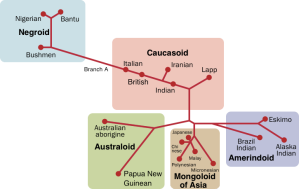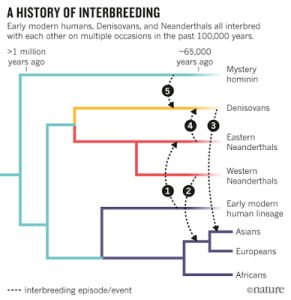When did Asians evolve?

The history of humanity’s long sojourn across the globe has resulted in, more or less, three main super-clades, or races: Sub-Saharan Africans, Caucasians, and Asians. The words we use for these are not perfect (“Caucasian” is particularly imprecise,) but do the job well enough.

The Asian super-clade has three main branches: Melanesians (and Aborigines,) who traveled south into the Pacific; the Native Americans, who settled North and South America some 13-40,000 years ago; and of course the East Asians, like the Chinese, Japanese, and Polynesians.
(Amusingly, Indians, though they clearly live in Asia, are part of the Caucasian clade because they are more closely related to Middle Easterners and Europeans than Chinese people. As a result, Indians were–for a while—recorded as “white” on US censuses, though today they are recorded as “Asian.”)
People are fond of saying that the SS African race contains the greatest genetic diversity (as well it might, due to the inclusion of groups like the Pygmies and Bushmen, who may have split off from other human groups over 100,000 years ago,) but the Asian race has the greatest pre-Columbian geographic/environmental range, stretching from Australia and Polynesia to Siberia and Greenland, from Mongolia to Patagonia.

Trying to offer a single, coherent description of the physical appearances of such a diverse range of peoples is nearly impossible. They range in skin tone from almost white to as black as most of Africa; in stature from slight, Pygmy-like Negritos to the formidable Comanches (who in the 1800s were among the world’s tallest measured people;) and in average reported IQs from >105 to >65. (Okay, IQ isn’t appearance.)
We will be able to speak much more meaningfully about appearances when we address each of the sub-races.
Here are the relevant portions from Haak et al’s lovely dataset:
On the left, we have the Native American DNA, from the depths of the Amazonian rainforest to the tribes of upstate New York. The olive green section are the Inuit/Eskimo and related Russian groups. The Inuit (who appear to have wiped out the earlier Dorset people,) share a great deal of DNA with other Siberians, eg the Yakuts (a Turkic people) and the Nganasan, (who speak a highly divergent language of the Samoyedic branch of the Uralic family, which also includes the Finnish, Hungarian, and Sami languages–language is a very bad guide to genetics.)
The pale peach are the Onge, who live in India’s Andaman Islands; purple the people of Papua New Guinea and Australia.
The very yellow part is all of the groups normally thought of as “East Asian,” like Japanese, Chinese, and Thai. Yellow is most dominant in the aboriginal people of Taiwan (who were there before the Chinese started migrating there in the past few hundred years,) and are the ancestors of the (not pictured) Polynesian peoples of Hawaii, Easter Island, and New Zealand. (I think they picked up some Melanesian DNA on the way.)
And on the right we have the various peoples of Siberia and central Asia.
I think it an open question whether the Melanesians and Aborigines ought to be properly classed with the other Asians, or awarded their own clade.

According to Masatoshi Nei, a biology professor at Pennsylvania State University,[131] the ancestors of today’s Asians and Caucasians split into two separate groups around 41,000 years ago, (give or take 15,000 years,) and their ancestors split from the ancestors of modern Africans–the “Out of Africa Event”–around 114,000 years ago, (give or take 34,000 years.)
The Daily Mail reports:
BERLIN (AP) — The human populations now predominant in Eurasia and East Asia probably split between 36,200 and 45,000 years ago, according to a study released Thursday.
Researchers used new techniques to analyze genetic samples from the shin bone of a young man who died at least 36,200 years ago near Kostenki-Borshchevo in what is now western Russia. The study, published in the journal Science, concludes that Kostenki man shared genetic sequences with contemporary Europeans, but not East Asians.
A separate study published last month in the journal Nature determined that a 45,000-year old sample found in Siberia contained sequences ancestral to both modern East Asians and Europeans.
In a genetic study in 2011, researchers found evidence, in DNA samples taken from strands of Aboriginal people’s hair, that the ancestors of the Aboriginal population split off from the ancestors of the European and Asian populations between 65,000 and 75,000 years ago—roughly 24,000 years before the European and Asian populations split off from each other. These Aboriginal ancestors migrated into South Asia and then into Australia…
The first complete sequences of the Y chromosomes of Aboriginal Australian men have revealed a deep indigenous genetic history tracing all the way back to the initial settlement of the continent 50 thousand years ago, according to a study published in the journal Current Biology today.
The Native Americans much more conveniently split off around 25,000 years ago.
Or in other words:

So on the one hand, race is biological and real, and on the other, it’s a social construct. Australian Aborigines are more closely related to other Asians than to, say, Europeans or Africans, but the Chinese are more closely related to Europeans than to Aborigines.
 One reason why Australians and other Melanesians appear so divergent from other Asian populations maybe their Denisovan (or other human) DNA. Most (if not all) human groups appear to have picked up DNA from some other, non-Homo Sapiens source. Europeans, East Asians, and Native Americans all have a small percent of Neanderthal DNA. Africans, IIRC, have a small % of some local African homin. And Melanesians/Australians have a small % of Denisovan DNA (Denisovans were a less-well-known cousin of the Neanderthals.)
One reason why Australians and other Melanesians appear so divergent from other Asian populations maybe their Denisovan (or other human) DNA. Most (if not all) human groups appear to have picked up DNA from some other, non-Homo Sapiens source. Europeans, East Asians, and Native Americans all have a small percent of Neanderthal DNA. Africans, IIRC, have a small % of some local African homin. And Melanesians/Australians have a small % of Denisovan DNA (Denisovans were a less-well-known cousin of the Neanderthals.)



Wonderful post w/ helpful graphs. Fascinating! Imagine the wanderlust of those first Easter Islanders!
LikeLike
Thanks!
I think they must have been following some birds and really hoping those birds wold get to land SOON!
LikeLike
Curious (to me, anyway) is the distance of the line separating the South Chinese from *bright green* Northeast Asians in the Cavaliers-Sforza linkage tree. Also not sure where the northern Chinese fit in?
LikeLike
From memory the North Chinese are with the Japanese, Koreans, etc.
LikeLike
If you take a good look at Haak’s dataset/the map, you’ll notice a genetic cline where groups in Siberia are mostly “red” with a little “yellow,” while groups in south east Asia are mostly Yellow with a little red. The completely pure yellow groups are aboriginal Taiwanese, while the pure red are from central far north Siberia. I regard this as evidence of (at least) two originally distinct population waves, one which diffused from the north and one from the south, but of course I may have the direction of travel backwards.
On top of that, the Melanesians/Aborigines, who got to the area first, may have left behind some DNA in southern Asia (Denisovan shows up in very low levels in southern Asia, higher in Tibetans who have been very isolated and who use their Denisovan DNA to survive up there,) which would make southern Asians tend to cluster toward Melanesians.
According to Haak’s graph, Northern Han are very close to Japanese and Koreans, but have slightly less of the red Siberian; they have slightly more red than the southern Han, though.
LikeLike
[…] Source: Evolutionist X […]
LikeLike
Does Haak have any Malagasy in his dataset, just interested in comparing them with both East Africans and other Asians?
LikeLike
Not that I remember, but off the top of my head, they’re Polynesians, descended from the aboriginal Taiwanese people, but probably with a lot of Melanesian and African mixed in–according to Wikipedia:
“Recent genetic studies on the Malagasy people showed that they have mixed African and Asian ancestries.[1] Three Malagasy populations, Temoro, Vezo, and Mikea, have approx. 70% African ancestry and 30% Asian ancestry.[1]
In a 2010 study, the Polynesian motif (mtDNA haplotype B4a1a1a) occurs frequency varied among three ethnic groups: 50% in Merina, 22 % in Vezo, and 13% in Mikea. There are two additional mutations (1473 and 3423A) founded in all Polynesian motif carriers of Madagascar, hence named the Malagasy motif.[2] Most likely scenario is that Madagascar was settled approximately 1200 years ago by a very small group, which consist of approx. 30 women; where 28 (93%) of them have Island Southeast Asian descent and 2 (7%) of them have African descent.[2]
The closest Asian parental population of the Malagasy are the Banjarese and other South Kalimantan Dayak people of south east Borneo.[1]”
LikeLike
[…] When did Asians evolve? […]
LikeLike
[…] previous posts, we discussed the evolution of Whites and Asians, so today we’re taking a look at people from Sub-Saharan […]
LikeLike